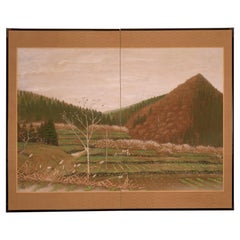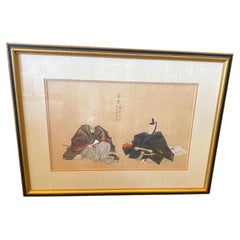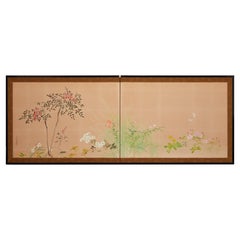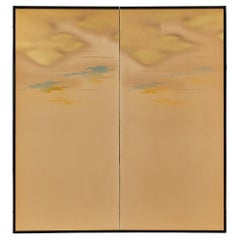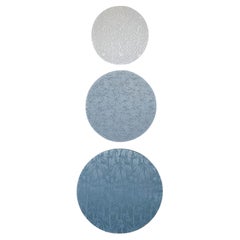Japanese Paintings and Screens
to
134
485
182
874
47
23
9
1
120
350
404
47
179
79
20
25
3
23
10
1
5
14
10
2
494
484
424
331
320
1,592
1,422
921
446
132
921
918
919
29
3
2
2
1
Place of Origin: Japanese
Japanese Two Panel Screen: Country Farm
Located in Hudson, NY
Unusual subject matter of a rural farm setting with grasses and pine in mineral pigments on paper with silk brocade border and black lacquer trim with bronze hardware. Signature and...
Category
Early 20th Century Japanese Paintings and Screens
Materials
Bronze
Japanese Asian Edo Period Tosa School Original Painting Imperial Court Officials
Located in Studio City, CA
A beautiful and very engaging Edo Period (1603-1868) Japanese Tosa school original painting featuring two officials from the Imperial Court.
The Tosa school (土佐派,) of Japanese pai...
Category
1830s Edo Antique Japanese Paintings and Screens
Materials
Wood, Paint, Paper
Japanese Two Panel Screen: Garden Scene
Located in Hudson, NY
Bamboo, chrysanthemums and garden stone in mineral pigments on a gold silk ground. Black lacquer trim with well patinaed bronze hardware. Signature and seals read: Seido Senshi
Category
Early 20th Century Japanese Paintings and Screens
Materials
Bronze
Japanese Two Panel Screen: Winter into Spring Floral Landscape
Located in Hudson, NY
With nandin, narcissus and chrysanthemums. Signature and seal read: Koun. Mineral pigments on mulberry paper with a silk brocade border.
Category
Early 20th Century Japanese Paintings and Screens
Materials
Brocade, Silk, Paper
Japanese Two Panel Screen: Clearing Skies
Located in Hudson, NY
Cloud formation in gold with blue skies in mineral pigments on mulberry paper with black lacquer trim.
Category
Early 20th Century Japanese Paintings and Screens
Materials
Gold
Vintage kimono textile art " Turquoise Forest ~Strength~ " by ikasu Blue, Japan
By Kimono ikasu
Located in Setagaya City, JP
Fabrics featuring iconic Japanese plants like chrysanthemum, maple, and bamboo were gathered from various long underwear and kimono pieces to create a set of canvases (diameter 30, 25 and 20cm) showcasing exquisite gradations.
The top canvas, in pristine white, originates from long under-kimono, while the middle and bottom canvases are skillfully upcycled from kimono fabrics.
<< Period / Story >>
The long under-kimono and kimono fabrics used in these canvases were originally crafted and worn during the late Showa period (1960-80ies).
<< Explanation and meaning of pattern and colors >>
The pattern on the top canvas features a chrysanthemum, an auspicious emblem symbolizing longevity. It is affectionately referred to as the "raccoon dog chrysanthemum" due to the large, overlapping petals resembling the fur of a muzina, a creature similar to a raccoon dog or badger. This motif is highly popular in various plant-inspired designs and frequently seen in Edo komon, katazome, and jimon textiles.
The top canvas naga-juban under-kimono, being entirely white and devoid of any additional dyes, suggests its use as formal wear. Its pristine white hue accentuates the silk's luster when exposed to light and highlights the beauty of the woven patterns.
The fabric used here is rinzu, a type of fabric thinner than crepe de chine, characterized by its soft, smooth texture and subtle sheen. This particular lintel distinguishes itself with the way its ground pattern emerges and also incorporates a woven chrysanthemum pattern.
The central canvas showcases a maple tree, symbolizing longevity, which changes its colors with the seasons, bringing joy and happiness to people's lives.
The bamboo featured on the lower canvas has been regarded as a symbol of good fortune since ancient times, given its straight and vigorous growth, along with the Chinese legend that a phoenix consumes its fruit. It embodies concepts such as "immortality," "longevity," and "strength" because it remains green even in winter. The hollow stem also signifies "innocence," suggesting that there are no hidden agendas.
All three canvases are adorned with ground patterns that, when viewed from a distance, appear as modern works of art, yet upon closer inspection, they reveal a distinct Japanese ambiance.
<< Characteristics of the fabric >>
All three canvases are made of fabrics with jimon. The unique and high level of Japanese weaving...
Category
1970s Japonisme Vintage Japanese Paintings and Screens
Materials
Canvas, Silk
Dutch Colonial Japanese Scroll Painting of Chief Merchant Doeff
Located in Amsterdam, NL
Nagasaki School (EARLY 19TH CENTURY)
Opperhoofd Hendrik Doeff with Javanese servant
Kakemono, watercolor on paper, mounted on silk and textile covered paper scroll, not signed....
Category
Early 19th Century Edo Antique Japanese Paintings and Screens
Materials
Silk, Paper
Japanese Two Panel Screen: Water Fowl by River's Edge
Located in Hudson, NY
Japanese Two Panel Screen: Water Fowl by River's Edge, Showa period (1926 - 1989) painting of fowl on a river bank. Very art deco in style. Painted in min...
Category
Early 20th Century Showa Japanese Paintings and Screens
Materials
Silk, Wood, Paper
Japanese Screen "the Song of Everlasting Sorrow"
Located in PARIS, FR
Six-panels screen depicting the exit from the city of a Chinese emperor on horseback and his concubine in a luxurious palanquin.
It may be a scene illustrating the poem The Song of Everlasting Sorrow (Chang hen ge, ???) written by Bai Juyi (772-846), which recounts the tragic love story between the emperor Ming Huang (also known as Tang Xuanzong, 685-762) and his favorite concubine, the beautiful Yang Guifei...
Category
Late 17th Century Antique Japanese Paintings and Screens
Materials
Silk, Wood, Paper
Pair of Japanese hinagata byôbu 雛形屏風 (small folding screens) with flower carts
Located in Amsterdam, NL
An amazing pair of six-panel hinagata byôbu (doll festival folding screens) with a continuous painting on gold leaf showcasing flower carts (hana’guruma) at the edge of a winding river.
Both laden with a large bamboo basket...
Category
Early 19th Century Antique Japanese Paintings and Screens
Materials
Gold Leaf
Japanese Six-Panel Screen, Audubon Landscape with Maple and Pine
Located in Hudson, NY
This is a Kano school painting depicting autumn and winter
Mineral pigments with gold dust on mulberry paper.
Category
Mid-18th Century Antique Japanese Paintings and Screens
Materials
Gold Leaf
Japanese Six-Panel Screen Plovers in Flight Over Coastal Landscape
Located in Hudson, NY
Japanese six-panel screen: Plovers in flight over coastal landscape. Late Edo - Early Meiji period, circa 1870, painting of plovers flying over cresting waves. Sumi ink on mulberry p...
Category
1870s Antique Japanese Paintings and Screens
Materials
Silk, Wood, Paper
Japanese Two-Panel Screen Three Jewels of Buddhism
Located in Hudson, NY
Japanese two-panel screen: Three Jewels of Buddhism. Meiji period (1868-1912) painting. The three jewels of Buddhism are the teacher, the lesson, and the ...
Category
Late 19th Century Meiji Antique Japanese Paintings and Screens
Materials
Silk, Wood, Paper
Japanese Two Panel Screen: Family of Chickens on Gold Leaf
Located in Hudson, NY
Mineral pigments on gold. Not signed, by Baikei Hitsu.
Category
1880s Antique Japanese Paintings and Screens
Materials
Gold Leaf
Japanese Two Panel Screen: Mandarin Ducks in Winter
Located in Hudson, NY
Fine painting of a variety of waterfowl in rich mineral pigments on gold leaf with a silk brocade border.
Category
19th Century Antique Japanese Paintings and Screens
Materials
Gold Leaf
Vintage kimono textile art " Plum Gradation " by ikasu Pink, White, Japan
By Kimono ikasu
Located in Setagaya City, JP
This canvas featuring a plum color gradient kimono showcases a unique decorative variation of the popular seigaiha (青海波) sea waves pattern.
The artwork got a Mr. & Mrs. Abe Arts & Cu...
Category
1980s Japonisme Vintage Japanese Paintings and Screens
Materials
Canvas, Silk
Vintage kimono textile art "View from the Window ~Maple&Plum~" by ikasu, Japan
By Kimono ikasu
Located in Setagaya City, JP
This work is a glorious nod to buddhist temples circle windows, with beautiful Japanese garden scape seen outside. Golden leaf on the border of a frame is an expression of light goin...
Category
1930s Japonisme Vintage Japanese Paintings and Screens
Materials
Gold Leaf
Japanese Two Panel Screen: Antique Kimono Fabric Mounted on Screen
Located in Hudson, NY
Japanese Two Panel Screen: Late Nineteenth Century Kimono Fabric Mounted on Early Twentieth Century Screen. In the Heian period (eighth century to the twelfth century), noblemen wou...
Category
Early 20th Century Meiji Japanese Paintings and Screens
Materials
Silk, Wood, Paper
Vintage kimono textile art "Snowflake ~New Beginnings~" by ikasu Purple, Japan
By Kimono ikasu
Located in Setagaya City, JP
Six canvases (Diameter approx. 30cm, 25cm, 20cm) use the fabric taken from antique kimono, its' various parts, to create one harmonious fluid image of a snowflake - a symbol of new b...
Category
1970s Japonisme Vintage Japanese Paintings and Screens
Materials
Canvas, Silk
Haku Maki Japanese Woodblock "Poem 69-17" Signed
By Haku Maki
Located in New York, NY
Haku Maki (1924-2000) Japanese Woodblock Poem 69-17. This art is from the Poem collection. Signed and numbered in pencil. Edition 15/86. Color wood blocking with embossing. Measures ...
Category
1960s Vintage Japanese Paintings and Screens
Materials
Paper
VIntage kimono textile art " Wish for prosperity " by ikasu Gold, Black, Japan
By Kimono ikasu
Located in Setagaya City, JP
This work is inspired by traditional Japanese nature colors symbolism, and is framed in paulownia wood originally used for a kimono chest-of-drawers.
It is filled with storytelling ...
Category
1960s Japonisme Vintage Japanese Paintings and Screens
Materials
Silk, Wood
MIEKO - Vintage Asian Style Painting on Paper - Signed - Japan - Late 20th C.
Located in Chatham, ON
MIEKO - Vintage Asian style painting on watercolor paper - signed with the artist's chop mark and name - Japan - late 20th century.
Excellent vintage condition - bleed through to th...
Category
Late 20th Century Anglo-Japanese Japanese Paintings and Screens
Materials
Paint, Paper
Japanese Two Panel Screen: Pine and Mountain Landscape By Muta Akira
Located in Hudson, NY
By rivers edge at sunrise. By: Muta Akira. Mica paint on canvas. Exhibited in the 1960 Nitten exhibition.
Category
Mid-20th Century Japanese Paintings and Screens
Materials
Canvas
Vintage kimono textile art "On Coral Waves ~Everlasting~" by ikasu Pink, Japan
By Kimono ikasu
Located in Setagaya City, JP
<< About this canvas >>
This kimono canvas set of three pieces portrays mountains surrounded by the sea. While each of the three pieces is crafted from different kimonos, they all s...
Category
1970s Japonisme Vintage Japanese Paintings and Screens
Materials
Silk, Canvas
Pair of Antique Carved Stone Panels, Japanese, Decorative, Figures, Victorian
Located in Hele, Devon, GB
This is a pair of antique carved stone panels. A Japanese, lacquered decorative scene with female figures, dating to the late Victorian period, circ...
Category
Late 19th Century Japonisme Antique Japanese Paintings and Screens
Materials
Stone
Japanese Six Panel Screen: Snow Scene
Located in Hudson, NY
Kano school painting of a pheasant in a snowy pine. Artist signature reads: Hokkyo Shunyo. Mineral pigments on gold leaf with silk brocade border.
Category
Early 19th Century Antique Japanese Paintings and Screens
Materials
Gold Leaf
Japanese Painting Depicting Commodore Perry’s Ship with Buddhist Monks Aboard
Located in Amsterdam, NL
A Japanese painting depicting Commodore Matthew Perry’s flagship USS Mississippi bringing the coffin with the remains of US marine private Robert Williams who died while serving on t...
Category
Mid-19th Century Edo Antique Japanese Paintings and Screens
Materials
Paint, Paper
Japanese Landscape Painting, Hanging Scroll Painting
Located in Greenwich, CT
Japanese scroll painting of landscape painting depicted village along the riverside in the mountains with fisherman
Ink and color on silk
Overall size...
Category
19th Century Antique Japanese Paintings and Screens
Materials
Silk
Antique Japanese Ink Hanging Scroll Hidaka Tetsuo with Wood Storage Box
By Hidaka Tetsuo
Located in Atlanta, GA
A hanging ink (Sumi-e) silk scroll by Japanese Zen artist Hidaka Tetsuo (1791-1871). Well presented in brocade boarders and mounted on paperback, this scroll depicts "Three Noble Friends in Winter" in a poetic and novel way. One of the favorite subjects by Chinese painters, the three noble friends in winter consists of pine, bamboo and plum flowers. They were admired for their characters of strength in cold resistance to remain evergreen and even blossom in unfavorable condition. The artist, however, composited the subjects in a none-conventional way as Ikebana. Bamboo and flowering plum branches were presented in an oversized pot...
Category
19th Century Japonisme Antique Japanese Paintings and Screens
Materials
Brocade, Wood, Paper
Set of 6 Large Kakemonos Japanese Mythology, 19th Century Japan circa 1800 Edo
Located in Beuzevillette, FR
Beautiful set of 6 large kakemonos from 19th century Japanese mythology.
Paper support with a canvas pasted on the paper
Wonderful set that is part of Japan's history and beliefs
When not hung, the Kakemonos are rolled up.
circa 1800 - Japan - Edo Period
A kakemono translates as "object to hang". In Japan this refers to a painting or calligraphy, most often done on silk or paper framed in a scroll that was intended to be hung on walls or in public lighting. This particular form, which allows them to be in a roll, dates back to the Tang dynasty in China (this would be related to the copying and preservation of ancient Buddhist texts). A Kami is a deity or spirit worshipped in the Shinto religion. A Yokai is a spirit, ghost, demon, or strange apparition from the creatures of Japanese folklore.
Each of these kakemonos represents a unique story:
- A kami, a Japanese deity, is shown painting a rainbow. Indeed, he performs the action with his right hand while his left hand holds a kind of basket with three pots of paint. This kami has a rather closed attitude. He is standing in a dark and tormented sky. Below this figure, 8 villagers are dressed in traditional Japanese clothes. Their faces are softened. They are not afraid of the elements made by the kami above their heads.
- A character with an unreal look is holding a kind of jar with his two hands, which he spills on human figures above. This being is floating in the air, probably a character from mythology, perhaps Susanoo. Underneath, villagers on umbrellas. They are trying to protect themselves as best they can from what is falling on them. One of them is carrying baskets with fish on her shoulders. A character in the background is thrown forward and falls.
- On this kakemono, the god Raijin, dressed in a white and blue outfit, strikes the sky with his two drum hammers to create lightning and its thunderous sound. Surrounded by Tomoe and a long red scarf, Raijin, enraged and with dishevelled hair, creates a dark and violent storm. The villagers seem frightened by this meteorological phenomenon. One of the villagers can be seen fainting in the arms of a man. This scene may seem chaotic, but Japanese legend tells us that once a field is struck by lightning, the harvest is good.
- On this kakemono, we see an unreal-looking figure holding a fan, as if he were sweeping away the bad weather, or simply producing gusts of wind. He is probably the kami of wind and air, Shina tsu-hiko. The figures below him seem surprised by so much wind. An umbrella flies away on the left, the women hold their hair and scarf, the clothes are caught in the power of the wind, there is even a woman on the ground on the bottom left.
- This Kakemono represents a short moment. This Raiju is a yokai (ghost spirit...
Category
19th Century Edo Antique Japanese Paintings and Screens
Materials
Paper
Japanese Important Tall Bronze Rabbit Girl Of Wonderland
Located in South Burlington, VT
"Rabbit Girl of Wonderland"
Japan, an important tall 35" hand cast bronze effigy of a young woman clutching a prize rabbit, by important national artisan ...
Category
20th Century Mid-Century Modern Japanese Paintings and Screens
Materials
Bronze
$10,000 Sale Price
62% Off
Early 19th Century Rimpa School Floral Screen
By Rimpa School
Located in Fukuoka, JP
Early 19th Century Rimpa School Floral Screen
Period: Early 19th Century
Dimensions: 367x171 cm (144.5x67.3 inches)
SKU: RJ118/2
This 6-panel gold-leafed screen is a splendid repre...
Category
Early 19th Century Edo Antique Japanese Paintings and Screens
Materials
Gold Leaf
K5 Japanese Antiques Hanging scroll, Sun, wave and crane, silk
Located in Niiza, JP
Silk, scroll tip: wood
Size: Image size: 400 (W) x 1240 (H) [mm]
All : 520 (W) x 1870 (H) [mm]
Box size: 80 x 75 x 630 mm, 840g (Not Original box)
Sun, wave and crane, a Japanese ...
Category
19th Century Antique Japanese Paintings and Screens
Materials
Silk
19th Century Japanese Six Panel Screen: Silver Moon Rising Over Summer Field
Located in Hudson, NY
Japanese Six Panel Screen: Silver Moon Rising Over Summer Field. Rimpa Style painting of a moon rising over summer flowers and grasses, including cockscomb and blue bellflowers. Pa...
Category
Late 19th Century Meiji Antique Japanese Paintings and Screens
Materials
Gold Leaf
Pair of Two Panel Japanese Screens: Mountain Landscape with Waterfalls and River
Located in Hudson, NY
Rivers of mist, falling water and moss draped trees evolve into a mystical landscape. Ink on silk, bordered in fine mulberry paper. Sold as a pair.
Category
Late 19th Century Antique Japanese Paintings and Screens
Materials
Silk
Japanese Two Panel Screen: Bamboo Grove on Mulberry Paper with Gold Dust
Located in Hudson, NY
Kano School painting of a bamboo grove with blooming flowers and gold dust mists. Painted in mineral pigments on mulberry paper with gold dust and a silk brocade border.
Category
Early 19th Century Edo Antique Japanese Paintings and Screens
Materials
Gold
Vintage obi textile art " Moon phase II " by ikasu Silver, Black, Japan
By Kimono ikasu
Located in Setagaya City, JP
<< About this artwork >>
This artwork has been upcycled from a stunning obi, which is adorned with calligraphy weaving saying "moon" and "moonlight".
<< Period / Story >>
The obi...
Category
1970s Japonisme Vintage Japanese Paintings and Screens
Materials
Silver Leaf
Japanese Two-Panel Screen Ikebana on Gold
Located in Hudson, NY
Japanese two-panel screen: Ikebana on gold. Meiji period (1868-1912) painting of a basket with beautifully arranged spring flowers in the style of ikebana (Japanese traditional flowe...
Category
Late 19th Century Meiji Antique Japanese Paintings and Screens
Materials
Gold Leaf
Japanese Two Panel Screen: Mountains in the Mist
Located in Hudson, NY
Chinese School landscape ink painting on gilded silk by Yukimatsu Shunpo, signed and dated 1924. Yukimatsu Shunpo was born in Oita in 1897 and studied under Himejima Chikugai in Osak...
Category
Early 20th Century Taisho Japanese Paintings and Screens
Materials
Silk
Japanese Two Panel Screen: Mandarin Ducks Among Dry Lotus
Located in Hudson, NY
Natural scene of Mandarin ducks gliding gracefully amongst the water.
Mineral pigments on silk with silk brocade border and natural wood trim. Seal reads: Kei.
Category
Early 20th Century Japanese Paintings and Screens
Materials
Silk, Wood
1844 - Chichi, Japanese Scroll Painting. Colour on Silk
Located in Kyoto, JP
Mother’s Breast (Chichi) 1844
Hanging scroll. Ink, pigments and gofun on silk.
Inscription:
Kouka era, dragon year, late winter, painted by Shozan Yashou
Artist’ seals:
...
Category
1840s Edo Antique Japanese Paintings and Screens
Materials
Silk
Japanese Two Panel Screen: Romping Cats Under Sago Palms
Located in Hudson, NY
Japanese Two Panel Screen: Romping Cats Under Sago Palms
Beautifully painted mineral pigments on mulberry paper
Category
17th Century Antique Japanese Paintings and Screens
Materials
Brocade, Paper
Fine Framed Japanese Painting of Samurais and Archers
Located in Greenwich, CT
refined Japanese brush painting of samurais and archers in the landscape, a section originally from a handscroll.
ink and color on silk. Cons...
Category
19th Century Antique Japanese Paintings and Screens
Materials
Silk
Japanese Two-Panel Screen, Rimpa Style Painting of Hollyhocks
Located in Hudson, NY
With the vibrant colors, and fine attention to detail and surface typical of a Rimpa painting. Using Rimpa style tarashikomi painting technique with mineral pigments on mulberry pape...
Category
Early 20th Century Japanese Paintings and Screens
Materials
Paper
Japanese Six Panel Screen: Moon Rising Over the Plains of Musashino
Located in Hudson, NY
Japanese Six Panel Screen: Moon Rising Over the Plains of Musashino. A classic motif in Japanese art. Japanese artists were used to seeing vistas with mountains, valleys, and fores...
Category
Late 19th Century Antique Japanese Paintings and Screens
Materials
Silver Leaf
VIntage kimono textile art "Geometry ~Marble~" by ikasu Gold, White, Grey, Japan
By Kimono ikasu
Located in Setagaya City, JP
This work is inspired by traditional Japanese nature motifs symbolism, and is framed in paulownia wood originally used for a kimono chest-of-drawers.
It is elegantly framed with pau...
Category
1960s Japonisme Vintage Japanese Paintings and Screens
Materials
Silk, Wood
Vintage kimono textile art "Flowers ~Life Circle~" by ikasu Pink, Black, Japan
By Kimono ikasu
Located in Setagaya City, JP
<< About this canvas >>
This canvas is crafted from three different haori fabrics, each adorned with a shibori dyeing flower motif going through entire fabric. These fabrics tell a ...
Category
1970s Japonisme Vintage Japanese Paintings and Screens
Materials
Canvas, Silk
Japanese Two Panel Screen Summer Flowers on Silver
Located in Hudson, NY
Japanese two panel screen: Summer flowers on silver. Meiji period painting (1868 - 1912) of Summer flowers including morning glories and daisies against a garden fence. Signature and...
Category
Early 1900s Meiji Antique Japanese Paintings and Screens
Materials
Silver Leaf
Japanese Six Panel Screen Mother Cat and Kittens Near Rushing Stream
Located in Hudson, NY
Kano School painting, in mineral pigments and gold leaf on mulberry paper with a silk brocade border. Artist seal reads: Hokkyo Unsen.
Category
Early 19th Century Antique Japanese Paintings and Screens
Materials
Gold Leaf
Japanese Six Panel Screen: Hawk with Ancient Pine Overlooking Twig Fence
Located in Hudson, NY
Beautiful and dramatic Kano school painting of a hawk perched on a rock. With flowering cherry, peonies, pine and bamboo. Twig fence on the right is made of heavily oxidized silver...
Category
18th Century Antique Japanese Paintings and Screens
Materials
Gold Leaf, Silver Leaf
'Two Dutch Ships Anchored in the Bay of Nagasaki' by Kawahara Keiga '1786-1860'
Located in Amsterdam, NL
Kawahara Keiga (1786 - c. 1860)
Two Dutch ships anchored in the bay of Nagasaki
Sumi ink and pigment on silk, H. 27 x W. 41 cm (excl. frame)
Comes framed, see image.
?Based o...
Category
Early 19th Century Antique Japanese Paintings and Screens
Materials
Silk
Japanese Two Panel Screen: Raku (Pleasure)
Located in Hudson, NY
Calligraphy reads: Raku (Pleasure). Ink on silver in a black lacquered wooden trim. Seal is illegible.
Category
Early 20th Century Japanese Paintings and Screens
Materials
Silver
Japanese Two Panel Screen Aviary Shaded by A Maple Tree
Located in Hudson, NY
Japanese Two Panel Screen: Aviary Shaded By A Maple Tree, Showa period (1926 - 1989) painting of an outdoor bird enclosure under a maple tree. Painted in ...
Category
Mid-20th Century Showa Japanese Paintings and Screens
Materials
Silk, Wood, Paper
Taisho Period Painted Silk Screen Depicting Nesting Cormorants by Asami Joujou
Located in Stamford, CT
An exquisite Taisho period screen depicting nesting cormorants painted on raw silk with gold fleck by Japanese artist Asami Joujou (b. 1890 in Himeiji, Japan-d. 1974), circa 1912-1926.
Category
1920s Taisho Vintage Japanese Paintings and Screens
Materials
Silk
Pair of Japanese Screens
Located in Schellebelle, BE
Exceptional pair of Japanese screens, 20th century
Six parts, six times 45 cm wide
Gold spotted paper with parts of old screens.
Category
Mid-20th Century Japanese Paintings and Screens
Materials
Paper
$6,496 / set
Japanese Two Panel Screen Mother and Puppies Under Bamboo
Located in Hudson, NY
Mineral pigments on paper. Signature and seal read: Shigehiro.
Category
Early 20th Century Japanese Paintings and Screens
Materials
Paper
Japanese Four Panel Screen Country Genre Scene
Located in Hudson, NY
Depicting farmers, pheasant hunting, picnicking, festival and general village scenes. Ink and mineral pigments on handmade mulberry paper.
Category
18th Century Antique Japanese Paintings and Screens
Materials
Paper
Vintage kimono textile art "Marble Story ~ Healing ~" by ikasu Grey, Japan
By Kimono ikasu
Located in Setagaya City, JP
This work uses a vintage kimono fabric with marble pattern, that makes it look like a real piece of marble.
The line in the middle symbolizes “kintsugi” - concept of wabi-sabi, which values imperfection, impermanence, and the beauty of aging.
It is elegantly framed with paulownia wood originally used for kimono chest-of-drawers, and is filled with storytelling and sense of luxury.
I used pieces of kimono that could no longer be used as clothing and kiritansu chest-of-drawers that would normally be discarded to create the ultimate upcycled piece.
<< Explanation and meaning of pattern and colors >>
Kintsugi (金継ぎ), which translates to "golden joinery" or "golden repair," is a traditional Japanese art form of repairing broken pottery with lacquer mixed with powdered gold, silver, or platinum. I used this tecnique here to "repair" antique kimono by transforming it into art work. Beyond its literal meaning of mending broken ceramics, kintsugi carries profound philosophical and cultural significance in Japanese tradition:
・Embracing Imperfection: Kintsugi celebrates imperfection and impermanence. Rather than disguising or concealing flaws, it highlights them, treating the breakage as part of the object's history. This philosophy encourages acceptance of imperfection as an essential aspect of life, beauty, and human experience.
・Wabi-Sabi Aesthetic: Kintsugi embodies the principles of wabi-sabi, an aesthetic worldview centered on the acceptance of transience and imperfection. Wabi-sabi values simplicity, authenticity, and the beauty of things that are imperfect, impermanent, and incomplete. Kintsugi exemplifies these principles by turning what might be considered flaws into features that enhance the object's beauty and character.
・Resilience and Transformation: The act of repairing broken things with precious metals symbolizes resilience and transformation. Instead of discarding or replacing the broken object, kintsugi honors its history and transforms it into something new and valuable. This reflects broader philosophical themes of overcoming adversity, finding beauty in imperfection, and embracing change.
・Honoring the Past: Kintsugi preserves and honors the history of the object. Rather than erasing or ignoring its past, it acknowledges and celebrates it. This aspect of kintsugi can be seen as a metaphor for honoring our own personal histories, including the challenges and setbacks we have faced, and recognizing how they have shaped us into who we are today.
・Spiritual and Philosophical Symbolism: Kintsugi has spiritual and philosophical implications, reflecting concepts such as the interconnectedness of all things, the cycle of life and death, and the pursuit of harmony and balance. The process of repairing broken objects with precious metals is seen as a metaphor for spiritual growth, enlightenment, and the journey towards wholeness.
Overall, kintsugi represents not only a practical technique for repairing ceramics but also a profound philosophical and cultural perspective on life, beauty, and the human experience. It embodies values such as resilience, acceptance, and the transformative power of embracing imperfection.
<< Characteristics of the fabric >>
This vintage textile is hand-painted with a traditional painting technique where the colors are added on wet surface, which creates an effect of marble.
<< About the frame >>
Kiritansu - chest-of-drawers for kimono, is traditionally made from paulownia wood, a uniquely Japanese material closely tied to the world of kimonos.
Paulownia wood is known as the lightest wood in Japan, prased for its natural luster, resistance to moisture, and resilience against cracking. Since ancient times, it has been used in crafting furniture, chests, and musical instruments.
During the Edo period, it became customary to store cherished kimonos in paulownia chests...
Category
1960s Japonisme Vintage Japanese Paintings and Screens
Materials
Gold Leaf
Japanese Six-Panel Screen, Chrysanthemums and Twig Fence With Gold Flakes
Located in Hudson, NY
Rimpa School painting in mineral pigments with gofun and gold flakes on mulberry paper with a silk brocade border.
Category
19th Century Antique Japanese Paintings and Screens
Materials
Gold
19th century Edo period's Hanging scroll Samurai players and child dancer
Located in Chiba, JP
Description - Hanging scroll with quite a surreal scene of the music and dance performance with two seated samurais and a child actor on a go-game-board who plays a role of dancing s...
Category
Mid-19th Century Japonisme Antique Japanese Paintings and Screens
Materials
Paper
Recently Viewed
View AllMore Ways To Browse
Lattice Panel Wood
Hanging Japanese Screen
Japanese Lattice
Japanese 19th Century Meiji Period Silk Painting
Japanese Buddhist Screen
Japanese Carved Screen
Japanese Screens And Doors
Japanese Autumn Screen
Japanese Screens Six Fold
Japanese Wood Room Divider
Kyoto Silk Painting
Japanese Dragon Painting
Japanese Birds Painted On Silk
Heian Period
Japanese Crane Panel
Japanese Divider Screen
Japanese Pheasant
Japanese Screen Chrysanthemums
